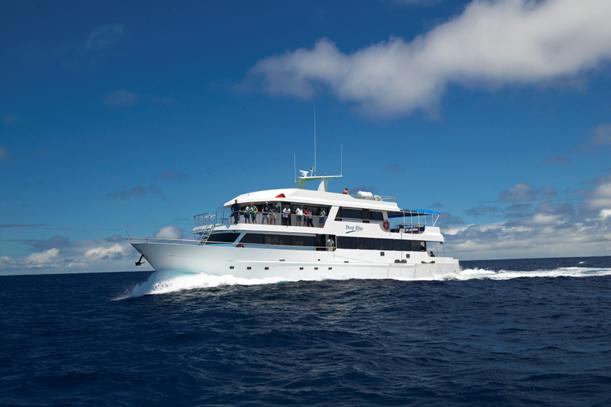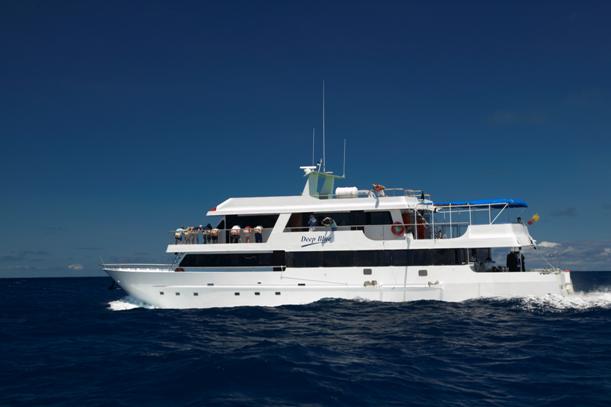
The Deep Blue Galapagos Diving Yacht presents this page who provide accurate information about our yacht and departures, to make easier the contact between visitors to Galapagos Islands. |
| Read more... |
 The Galápagos Islands (Official name: Archipiélago de Colón; other Spanish names: Islas de Colón or Islas Galápagos, from galápago, "saddle"—after the shells of saddlebacked Galápagos tortoises) are an archipelago of volcanic islands distributed around the equator, 972 km west of continental Ecuador in the Pacific OceanCoordinates: 0°40′S, 90°33′W. The Galápagos Islands (Official name: Archipiélago de Colón; other Spanish names: Islas de Colón or Islas Galápagos, from galápago, "saddle"—after the shells of saddlebacked Galápagos tortoises) are an archipelago of volcanic islands distributed around the equator, 972 km west of continental Ecuador in the Pacific OceanCoordinates: 0°40′S, 90°33′W.The Galápagos archipelago, with a population of around 40,000, is a province of Ecuador, a country in northwestern South America, and the islands are all part of Ecuador's national park system. The principal language on the islands is Spanish. Etymology The archipelago has been known by many different names, including the "Enchanted Islands," because of the way in which the strong and swift currents made navigation difficult and also because of the beautiful geography and biodiversity. The first crude navigation chart of the islands was done by the buccaneer Ambrose Cowley in 1684. He named the islands after some of his fellow pirates or after the English noblemen who helped the pirates' cause. More recently, the Ecuadorian government gave most of the islands Spanish names. While the Spanish names are official, many users (especially ecological researchers) continue to use the older English names, particularly as those were the names used when Charles Darwin visited. "Galapago" is an old Spanish word, meaning saddle. The large Galapagos Tortoises on some of the islands had a shell that resembled an old Spanish saddle, thus the name. The tortoise is a unique animal found only in the Galapagos Islands, yet there are no more than 200 in the 13 main islands. Physical Geography Located in the eastern Pacific Ocean at 972 km off the west coast of South America. The closest land mass is the mainland of Ecuador to the east (the country to which they belong), to the North is Cocos Island 720 km and to the South is Easter Island and San Felix Island at 3200 km. The islands are found at the coordinates 1°40'N-1°36'S, 89°16'-92°01'W. Straddling the equator, islands in the chain are located in both the northern and southern hemisphere with Volcan Wolf and Volcano Ecuador on Isla Isabela being directly on the equator line. Española the southernmost island and Darwin the northernmost island are spread out over a distance of 220 km. The Galapagos Archipelago consists of 7880 square km of land over 45,000 square km. The largest of the islands, Isabela, measures 4,588 square km and making up half of the total land area of the Galapagos. Volcan Wolf, on Isabela is the highest point with an elevation of 1,707 m above sea level. The group consists of 16 main islands, 6 smaller islands, and 10 rocks and islets. The islands are located at the Galapagos Triple Junction. It is also atop the Galapagos hotspot, a place where the earth's crust is being melted from below by a mantle plume, creating volcanoes. The oldest island is thought to have formed between 5 and 10 million years ago. The youngest islands, Isabela and Fernandina, are still being formed, with the most recent volcanic eruption in 2007. Conservation Though the first protective legislation for the Galápagos was enacted in 1934 and supplemented in 1936, it was not until the late 1950s that positive action was taken to control what was happening to the native flora and fauna. In 1955, the International Union for the Conservation of Nature organized a fact-finding mission to the Galápagos. Two years later, in 1957, UNESCO in cooperation with the government of Ecuador sent another expedition to study the conservation situation and choose a site for a research station. In 1959, the centenary year of Charles Darwin's publication of The Origin of Species, the Ecuadorian government declared 97.5% of the archipelago's land area a national park, excepting areas already colonised. The Charles Darwin Foundation was founded the same year, with its international headquarters in Brussels. Its primary objectives are to ensure the conservation of unique Galápagos ecosystems and promote the scientific studies necessary to fulfill its conservation functions. Conservation work began with the establishment of the Charles Darwin Research Station on Santa Cruz Island in 1964. During the early years, conservation programs, such as eradication of introduced species and protection of native species, were carried out by station personnel. Currently, most resident scientists pursue conservation goals; most visiting scientists' work is oriented towards pure research. In 1986 the surrounding 70,000 square kilometres (43,496 sq mi.) of ocean was declared a marine reserve, second only in size to Australia's Great Barrier Reef. In 1990 the archipelago became a whale sanctuary. In 1978 UNESCO recognised the islands as a World Heritage Site, and in 1985 a Biosphere Reserve. This was later extended in December 2001 to include the marine reserve. |
- deepbluegalapagosdiving.com

